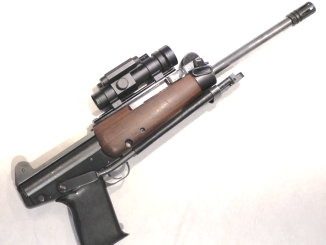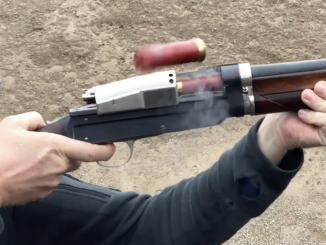Today I’m answering some questions sent in last week – I think this will be a fun and interesting regular feature for the site. If you have a question you’ve been wondering about, please email it to me, and I’ll see if I can get you an answer for the next Reader Questions column! I did get many more than I have the space to answer for this week, so I picked a couple to cover. We start with this email from Aaron:
Question #1: 6.5x55mm Chamber Spec
I once bought a Norwegian Krag-Jorgenson chambered for 6.5x55mm and had concerns about the head space, especially given the design with a single locking lug. After acquiring a field gauge in 6.5×55 Swedish, I found the action would close on it and it made me concerned about the safety of shooting the rifle. I also contacted an author of a small book on Swedish military rifles and he told me there were two different cartridges that were very similar, “6.5x55mm Swedish” and “6.5x55mm Scandinavian” but they were not strictly interchangeable in all action types. I didn’t keep the rifle but always wanted to know more about the two different 6.5 cartridges and the guns for them.
Well, there are sort of two different cartridges…and sort of only one. Back in 1893, Sweden and Norway were joined under a somewhat unified government, and decided to adopt a single military rifle cartridge for both countries, despite the Swedes using a Mauser rifle and the Norwegians using a Krag rifle. A common set of chamber dimensions and tolerances were agreed upon, as well as a standard maximum pressure (46,000 CUP). However, when production got going, the Swedes used a chamber right on the minimum side of the tolerances (presumably for better accuracy) and the Norwegians chose to use one on up at the maximum end of the tolerances (presumably for reliability).
A Swedish committee was actually formed to investigate the specs after it was alleged that Norway was making ammunition that wouldn’t fit in Swedish rifles, while the Swedish ammo would fit Norwegian rifles. The ultimate finding was that both nations were within the technical dimensions allowed, but they were still far enough apart that sometimes Norwegian ammo would be tight to chamber in a Swedish rifle. And that is the reason why your Norwegian Krag was able to close on that Field gauge. Since Swedish Mausers are far more common here in the US than Norwegian Krags, the headspace gauges were most likely designed around the tighter chamber dimensions of the Swedish Mauser.
The 6.5×55 Scandinavian (or 6.5×55 Skan) is a slightly different matter. It was formally defined in 1990, in response to a desire of modern shooters to have a more precise chamber spec than the original 6.5×55 agreement provided. The 6.5×55 Skan is in some ways like the .223 Wylde – it is a chamber spec rather than a cartridge one, and has a higher rated chamber pressure to give better performance in new-production rifles. It has no direct impact on the older surplus guns, except so far as ammunition made to its pressure should probably not be used in Krag rifles (the Swedish Mausers should be fine with it). If you are using military 6.5x55mm ammo it should be loaded to 48k PSI, and will function just fine in both Norwegian Krags and Swedish Mausers.
Question #2: Side-Mounted Oprods
Is there such a thing as a rifle with a gas tube on the side of the barrel instead of on top or below?
There are, but not many. The most common place where you will see side-mounted operating rods is in the experiments converting bolt action rifles to semiautomatic. The rifles being converted typically already had sights down close to the barrel that would preclude a top-mounted oprod and magazines on the bottom that would preclude a bottom-mounted oprod. So out of necessity, they often got mounted on the side. Examples of this are the Howell, Charlton, and Cei Rigotti (although technically the Cei Rigotti has the oprod on the bottom and the spring guide on the side).
Generally, the operating rod is mounted on the top or bottom or a rifle to keep the axis of balance directly through the middle of the bore.
Question #3: Madsen M47 Stripper Clips
In your video on the Madsen M47 bolt action you load it with stripping clips. What kind of clips and where can I get some for my M47? Thanks again.
When Colombia adopted the M47, it was making use of a lot of cheap USGI .30-06 ammunition, which was often packaged on M1903 clips – so that is the clip design they requested from Madsen. I don’t know if Colombia actually manufactured its own clips for the Madsen rifles (I’ve never seen one), but for shooting purposes you can just use US clips. The same ones were used for the M1903 Springfield series and the M1917. You can also use M14 clips, although they may wobble a bit when you strip the cartridges off them. Mauser clips of many varieties will also work reasonably well in a pinch.
I hope you found these interesting! If you have a question you would like to have addressed next week, send it to me!




The Columbia Madsen M47 must have been before I subscribed, or I otherwise missed it somehow. I have two of these, unissued, sequentially serial numbered, and so would like to check out that video. Can you send the link to my email, please? Thanks! (Great information on everything, by the way. Keep ’em coming.)
Oops, sorry. Found the link over on the CMP Forum. I guess I could probably dig and find it on here, too? Forgot to mention: My two sequentially-numbered Madsens have matching sequentially-numbered bayonets. The rifles and the bayonets are made like fine (but very sturdy) furniture, very high quality materials and fit/finish.
Another ‘rifle system’ (machine gun, actually, or at least IAR) is the ARES Shrike weapon system: http://world.guns.ru/machine/usa/ares-shrike-e.html
As Ian has stated: somewhat of a modification of an existing concept, although not from bolt action to self loading rifle, but from assault rifle to belt (or dual) fed squad automatic weapon.
The Steyr Aug and the TRW Low Maintenance Rifle are two more examples of assault rifles with a side mounted gas system.
Many Thanks for answering my question about M47 clips. I’ve tried Mauser 98 and 93 clips and M14 clips and they do work [sort of] but were obviously not correct. Again, Many Thanks.
… and yet another one I forgot to mention in my reply: the TWR low maintenance rifle (LMR): http://world.guns.ru/assault/usa/trw-lmr-e.html, having the long stroke gas piston an the right side of the receiver.
Although I doubt the rifle has ever seen production or even been issued.
And I hope Maxim Popenker doesn’t mind using links to his very informative homepage 😉 (not fishing for compliments)
Concerning Question #2
Actually Steyr AUG has a gas piston at about 4 o’clock position (when looking from breech side). However, at 8 o’clock it has the charging handle rod, which also balances weight distribution.
I seem to remember that the Japanese copy of the ZH29 has a gas piston slightly to on side
The ARES Shrike belt-feed M-16 system also uses a side-mounted gas op system.
&,5 X 55 was developed in Norway, and are exaktly alike. thr Krag, was not as strong as the Mauser, so a lighyrt load, was used in Norway. Sweden and Norway, was in union from 1812 to 1905
It’s little known, but the original AR-10 prototypes ran the gas tube along the left side. By serial number 30, the design had changed to a top gas tube like the AR-15 we know today.